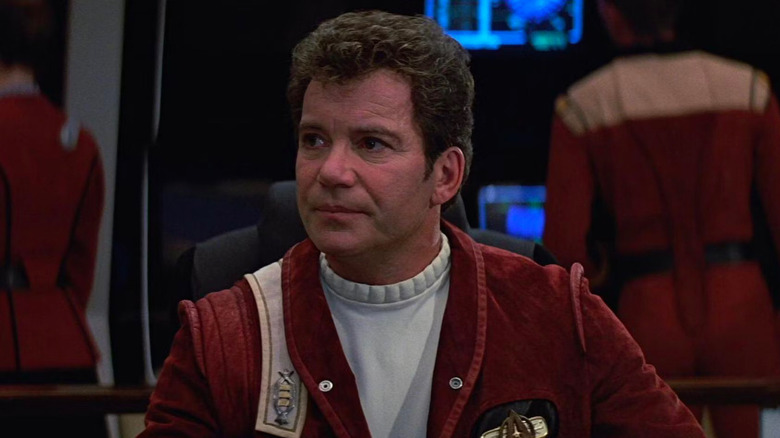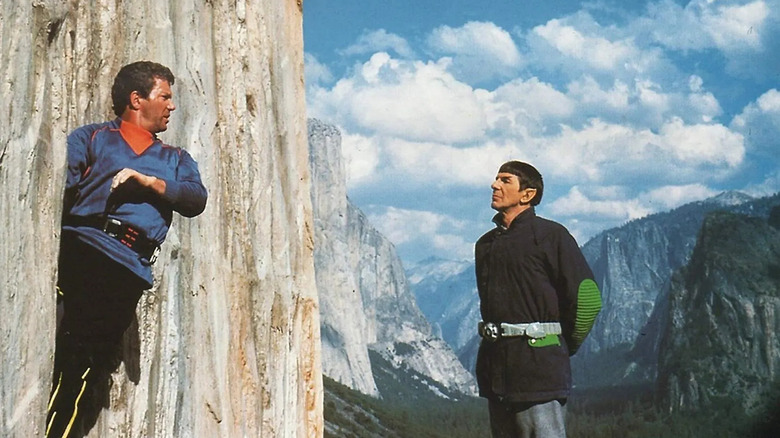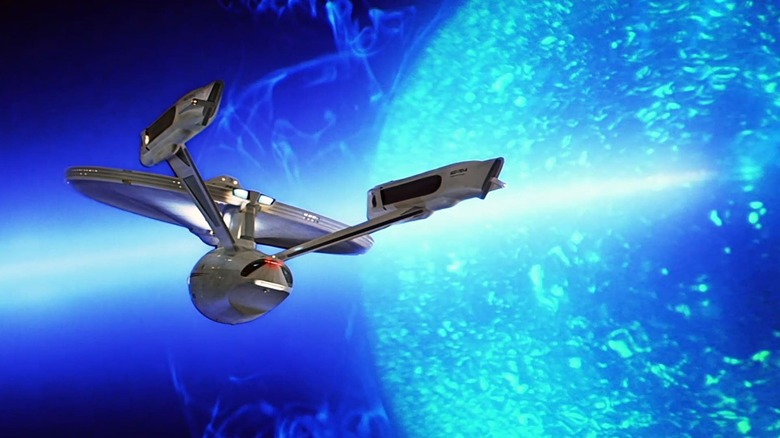William Shatner Regrets His Biggest Star Trek Failure
In his vast career, William Shatner has directed five features. Three of them were documentaries about the making of "Star Trek" including "The Captains" in 2011, "Get a Life!" in 2012, and "Chaos on the Bridge" in 2014. Prior to these, Shatner also helmed a 2002 sci-fi film called "Groom Lake," which he co-wrote with the notorious "Star Trek" producer Maurice Hurley.
Shatner's highest-profile directing gig, however, came in 1989 with the release of "Star Trek V: The Final Frontier." To this day, "Star Trek V" is considered the least of the "Star Trek" movies, lambasted for its clunky script, weird central conceit, and cheap special effects. In the film, the U.S.S. Enterprise is hijacked by Sybok (Laurence Luckinbill), the half-brother of Spock (Leonard Nimoy). Sybok flies the ship to the very center of the galaxy where he hopes to meet God face-to-face. Along the way, Sybok converts several Enterprise crew members to his cult of joy and pain-free living. The film's climax features the appearance of God Himself ... or rather a very powerful psychic alien who claims to be God in order to steal a starship.
Kirk (Shatner) is the one who asks the logical question of why God would need a starship.
It's an odd concept, but appropriately ambitious for the franchise. How would the humanist universe of "Star Trek" react to the physical appearance of God? It posits interesting questions about faith and the nature of the universe. Sadly, the film was largely bungled, mostly thanks to a rushed script, studio cuts, a writer's strike, and myriad other production troubles.
In a recent interview with the Hollywood Reporter, Shatner expressed extreme regret over how "Star Trek V" turned out, feeling that he should have been able to push back against Paramount.
The production of Star Trek V
When making "Star Trek IV: The Voyage Home," Shatner had a pay dispute with Paramount, and he agreed to appear in "Voyage" only under the stipulation that he be allowed to direct its sequel. Shatner also had a clause in his contract (going way back to the 1960s) vis-à-vis Leonard Nimoy, stating that he and his co-star would be given raises and job opportunities at the same time. Nimoy directed "Voyage" as well as "Star Trek III: The Search for Spock," allowing Shatner to leverage his way into the director's chair. He also, as part of the deal, was allowed to write a treatment.
While making "Voyage," Shatner penned said treatment, coming up with a story about how the Enterprise was hijacked by, essentially, a televangelist. The idea was that the televangelist character would take the Enterprise to meet God at the center of the galaxy, but instead find Satan living there (which would have been in continuity with a "Star Trek: The Animated Series" episode). It was producer Harve Bennett who insisted that the idea be reworked.
Shatner could have pushed back, but didn't thanks to his inexperience as a director. He said:
"I wish that I'd had the backing and the courage to do the things I felt I needed to do. My concept was, 'Star Trek goes in search of God,' and management said, 'Well, who's God? We'll alienate the nonbeliever, so, no, we can't do God.' And then somebody said, 'What about an alien who thinks they're God?' Then it was a series of my inabilities to deal with the management and the budget. I failed. In my mind, I failed horribly."
It was, it seems, a failure of command, not of ambition.
Ill-equipped for command
Trekkies weren't satisfied with "Star Trek V" and, it seems, neither was Shatner. The actor said:
"When I'm asked, 'What do you regret the most?,' I regret not being equipped emotionally to deal with a large motion picture. So in the absence of my power, the power vacuum filled with people that didn't make the decisions I would've made."
Of course, with a large studio project like "Star Trek V," it's wholly possible that the studio would have interfered even with a stalwart director. Even when the interviewer, Aaron Couch, defends Shatner's decisions, the actor insists that he was still to blame. He remembered his idea for a team of enormous rock monsters to attack Kirk on the Hell planet during the film's finale ... and how it just wasn't practical. Shatner's ideas were a little too big for what he was able to do. He recalled:
"It is on me. I wanted granite [monsters] to explode out of the mountain. The special effects guy said, 'I can build you a suit that's on fire and smoke comes out.' I said, 'Great, how much will that cost?' They said, '$250,000 a suit.' Can you make 10 suits? He said, 'Yeah.' That's $2.5 million. You've got a $30 million budget. You sure you want to spend [it on that]? Those are the practical decisions. Well, wait a minute, what about one suit? And I'll photograph it everywhere."
In 1989, it felt like "Star Trek" might be wrapping up, ready to let "Star Trek: The Next Generation" take over on the small screen. Luckily, Shatner and the original Enterprise crew returned for "Star Trek VI: The Undiscovered Country," a much better movie and a great way to wrap up the grand human adventure.


